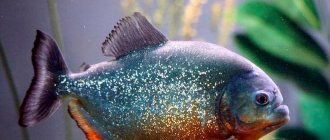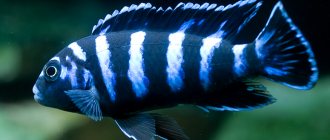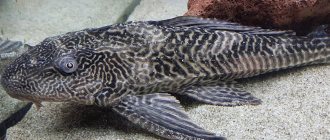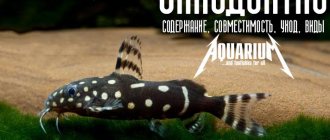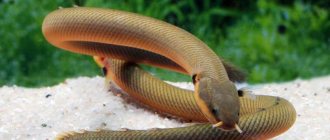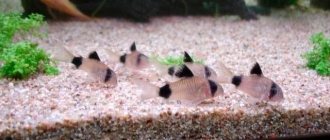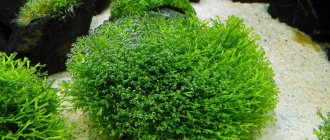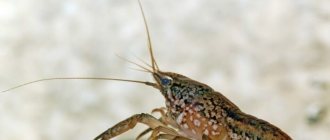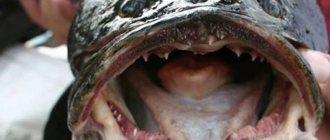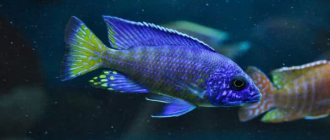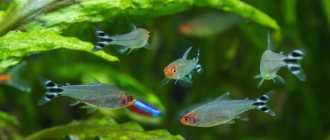Pacu fish, herbivorous piranha, is a freshwater fish of the piranha family. In nature, they are found in the Amazon and Orinoco, standing and flowing reservoirs of their basins.
It has been present in the European classification since the beginning of the 19th century.
Fish farming and fishing facility. Kept in aquariums. They are also found in natural reservoirs of North America and Asia, where they are considered harmful fish, displacing natives. They are bred in nurseries all over the world.
The pacu fish is a conditional herbivore. Juveniles feed on small crustaceans, gastropods and insects washed into the water by rain. The adult prefers plant foods. They can crush nuts.
Natural enemies are local dolphins and crocodiles.
Description
Representatives of piranha pacu are similar in physique and lifestyle.
Appearance
The body shape is an ellipse, laterally compressed to a disk. The anal and dorsal fins are quadrangular, tapering towards the tail. The anal is extended to the tail. The caudal fin is forked. The scales are small, with a silvery sheen.
The eyes are large and mobile. The mouth is large and oriented forward.
The teeth are quadrangular, similar in structure to human molars.
Behavior
- They keep to themselves in the aquarium. They form pairs during spawning.
- They are leisurely, but are active during feeding.
- They eat plants, including hard-leaved plants.
- They do not exhibit any predatory habits, but they will swallow an unwary fish.
- Shy, afraid of sudden movements and loud sounds.
Lifespan
The oldest caught in nature is 28 years old. In captivity - 12–15 years.
Differences between piranha pacu and red piranha
- The color is similar to the smallest detail.
- The teeth of a predatory piranha resemble the points of a pike in appearance. The peculiarity of the bite is externally expressed in the characteristically protruding lower jaw.
- The red pacu piranha is twice the size. A one-year-old pacu corresponds to the size of an adult predatory piranha.
- Red piranha is a pronounced schooling fish.
Fish with human teeth
Pacu is a freshwater fish that originally lived in the rivers of the Amazon and Orinoco basins. Unlike the notorious predators - piranhas - the red pacu has a tooth structure similar to that of humans. They are also adapted for eating plant foods; even the shells of nuts lend themselves to the powerful jaws of the pack. However, cases of injury to people by this fish are not uncommon.
In the wild nature of the Amazon, the fish “fat” up to 30-40 kg of live weight, reaching a meter or more in length. Naturally, a bite from such a “monster” is fraught with consequences, including traumatic amputation.
The lack of control over fish farming has led to the fact that various types of piranhas have colonized the freshwater bodies of other continents. Nowadays you can find her:
- On the islands of the Caribbean.
- In rivers and lakes of North America.
- In Europe.
- On the islands of the Pacific region.
The red pacu has a tooth structure similar to that of a human.
Irresponsible aquarium owners release their pets into the nearest body of water, and if the pacu manages to acclimatize, then it occupies its niche, displacing local species.
After cases of attacks by “vegetarian” predators on swimmers became known, the authorities of some cities banned swimming in reservoirs where this fish was spotted. And on the island of New Guinea, where the pacu, having settled in, feels “at home,” it has become a serious threat to local fishermen. Among the Papuans, this species was called “ball katu,” which translated means “cutting off the genitals.”
When purchasing such an exotic and dangerous inhabitant of a home aquarium as a red pacu, the maintenance of which requires considerable experience and skill, you should critically evaluate your capabilities so that instead of a cute curiosity you do not end up with a dangerous neighbor.
Kinds
Red pacu and black pacu are common in aquariums.
Black pacu
Aka brown pacu (Colossoma nigripinne, Piaractus macropomum). The name "Piaractus macropomus" is incorrect. The abundance of Latin names is explained by the separation of the previously brown pacu into a separate species.
The dominant color is from gray to black. The abdomen is light. In some cases, the anterior part of the abdomen and lower jaw have a pink tint.
The maximum body length in nature is up to 1.08 m with a weight of 40 kg. The typical size is 70 cm. It does not grow like that in an aquarium. Depends on the volume of the vessel.
Red
Called Piaractus brachypomum, red-bellied pacu or two-toothed colossoma (Colossoma bidens).
The dominant color is darker. Caudal fin with a vertical dark stripe. The bottom of the gill covers, lower jaw and abdomen are red/orange. The pectoral and anal fins are red/orange.
The largest specimen captured was 0.88 m in length. Weight - 25 kg.
What to feed
In nature, the black pacu feeds on small invertebrates and fish, fruits, aquatic plants, nuts, seeds and grains. The aquarium will be happy to eat dry food of the appropriate size, for example, Tetra Cichlid XL Sticks, Tetra Cichlid Algae. Food is taken from the surface and in the water column. Plant foods must be alternated with protein foods. Feed your pets with lettuce, spinach, pieces of cucumber, and zucchini.
An impressive 35kg black pacu caught in Lake Corrego das Antas by Marcio David
Content
The main problem of keeping is the size of the aquarium fish. Adapts to changing conditions. Resistant to diseases.
The conditions for keeping black and red pacu are similar.
Currents in the aquarium are welcome.
Piranha is a timid and nervous fish. Feels confident in the company of 3-4 relatives.
Aquarium for piranha
For an adult, a capacity of 1.5 cubic meters is required. The approximate size of the aquarium (WxHxD) is 2000 x 750 x 1000 mm. In a species aquarium - from 0.8 m3 per individual.
For soil, use pebbles with 1–2 cm fragments or a sandy substrate. The paku fish looks harmonious against a light background.
He eats live plants, but tries artificial and fixed ones. Hang driftwood, massive stones, and rocks as shelters.
Water parameters
- Temperature: 24–27 °C. You will need a heater with a thermostat with a power of 1 W per 1 liter of capacity.
- Hardness: 1–5 °F.
- Acidity: pH 5–7.5.
Breeding
Due to their large size, raising fish at home is difficult and impractical. Individuals sold in stores are bred on special fish farms in large artificial ponds.
Fish become sexually mature at the age of three years. If a couple lives in a common aquarium, they are placed in a separate container with a water temperature of 26-29 degrees and soil. The male prepares a nest in the ground, and the female lays eggs there. The male fertilizes the eggs and guards them.
After 5-7 days, the fry appear, which are constantly sorted, as the large ones begin to prey on the small ones. 500 fry up to 1 month can be kept in an aquarium with a volume of 150 liters or more. After another month, the juveniles are transplanted into a 250 liter aquarium.
Reproduction
Sexual dimorphism is weakly expressed. Females are larger in size, with a swollen abdomen.
Breeding in captivity is problematic. Young individuals are supplied to stores from nurseries.
Hormonal injections are used for spawning. The parents do not care about the eggs; they eat the fry.
The fry need constant sorting. Developed individuals are prone to cannibalism. They are fed daphnia and artemia. Plant food - phytoplankton, large algae. In nurseries they provide artificial food.
Sexual maturity is reached at 12–20 months.
Feeding
The diet should be balanced.
The basis is vegetarian food: lettuce, various grains, chopped fruits and vegetables (pumpkin, cabbage, tomatoes, etc.), grapes, you can use bananas or other tropical fruits that grow in the natural habitat.
You also need to feed organic food: bloodworms (preferably large ones), insect larvae, snails, worms, crustaceans. You can feed fish fry and raw meat, but use it with caution so as not to cause aggressiveness. The most important thing is that there should be a lot of food. They usually feed once during the day so as not to overfeed and increase waste. Proper nutrition helps strengthen the immune system and increase life expectancy.
Photo gallery
Where does it live?
The fish, called pacu, is the only one in the world whose teeth are shaped like molars and incisors of humans. In nature, this fish can be found in the waters of the Amazon, Orinoco, Parana and Uruguay. Inhabits fresh water bodies:
- rivers;
- ducts;
- lakes;
- backwaters.
They cannot spawn in salt water and live only in warm waters. These are the conditions that will be most comfortable for them. This fish can also be found in other bodies of water in the world. This happens because careless aquarists throw it into bodies of water because they failed to cope with keeping it in the aquarium.
Metynnis argenteus, Ahl, 1923.
Metinnis silver photo
A small variety of Piranha. It has a silver-gray body color with chaotically scattered dark warts. The anal fin of the male is veiled, while that of the female is straight and reddish.
Synonyms: silver dollar fish.
Body length: from 10 to 14 cm.
Water parameters: t from 22 to 27 0C, dKH < 1°, dGH up to 5°, pH from 6.5 to 7.0.
Food: omnivore.
Habitat: rivers of the Orinoco and Amazon basins.
Lifestyle
In its natural habitat, pacu lead a gregarious lifestyle. Aquarium fish also live in schools. Traditionally, everyone lives together - young animals and adults. Together they hunt prey.
The brown pacu leads a solitary lifestyle and does not live in a flock. The basis of its diet are: zooplankton, snails, insects, and smaller fish. Before reaching sexual maturity, young individuals live closer to the bottom, in the muddy water of the river. They are distinguished by excellent immunity and body resistance to various diseases.
Yandex pictures
Predators behave differently in natural conditions and when kept artificially. Those predatory representatives of the species that inhabit rivers and lakes show aggression and courage, quickly rushing at their prey. They have lightning-fast reactions. Therefore, they can feed not only on aquatic inhabitants, but also on birds, which also hunt fish.
Aquarium fish differ in their personalities. When they get into captivity, they become shy. When stressed, they behave unnaturally. If you shake the water in an aquarium and knock on it, the fish falls to the side and falls to the bottom. If you give the fish a treat, it quickly rushes to it and tears it into small pieces. In stressful situations, they will conflict with each other and may injure or traumatize their relatives. Herbivores do not show aggression. They can be attacked by predatory fish and alligators.
Important. According to ichthyologists, such a fish should not become a pet for ordinary aquarists. It often happens that a person is unable to cope with the cultivation of pacu and throws it into water bodies.
Metynnis luna, Cope, 1878.
Lunar Metinnis photo
Representatives of this species are very tall-bodied, silvery with a reddish spot behind the gill cover. The anal fin is veiled in males, reddish in females. They mature at 1.5 years. Metinnis are herbivorous fish that can damage or completely destroy plants. They enjoy eating cabbage and lettuce leaves.
Body length: up to 25 cm.
Water parameters: t from 26 to 28 0C, dKH < 1°, dGH up to 15°, pH from 5.0 to 6.8.
Food: omnivore.
Habitat: Amazon river basin.
Natterer's piranha (Pygocentrus nattereri), Kner, 1858.
Piranha Natterera photo
Also known as "saikanga". This variety of Piranha received its name in honor of the Austrian scientist Johann Natterer. Juveniles of this species have a very bright bluish body color. The chest and paired fins are red, the caudal fin is black with a wide blue vertical stripe. The back is dark in color. After 8 months, the fish changes color and becomes gray-silver, the sides turn pink, the spots fade or disappear altogether, but small golden sparkles appear. The anal fin becomes lighter, and with the onset of spawning it becomes completely red. During this period, the length of the Piranha should exceed 8 cm. The upper row of teeth is smaller than the lower one. Female Natterer's Piranhas are slightly larger and thicker than males. The keel of the male's abdomen from the front looks like the Latin letter V, and in females it looks like a U. The shape of the anal fin of the male is pointed, while that of the female is rounded.
Synonyms: Common piranha.
Body length: maximum up to 60 cm, usually up to 35 cm.
Water parameters: t from 26 to 28 0C, dKH < 2°, dGH up to 14°, pH from 6.2 to 7.2.
Food: omnivore.
Habitat: rivers of Brazil, Argentina, Colombia, Venezuela, Paraguay, Guyana.
Aquarium
Aquarium fish need to be provided with proper living conditions. Temperature readings must be at least 25 degrees Celsius. For an aquarium you need to equip it with high-quality equipment - a filter, a compressor, lighting.
Yandex pictures
Only settled water should be added. You can buy catfish as neighbors when kept artificially. You should not pick up the fish, it can be dangerous and can bite with its sharp teeth.
